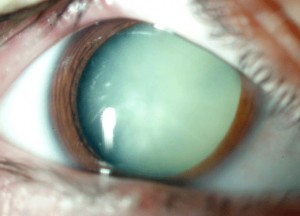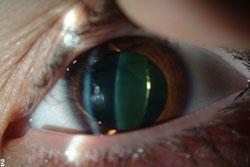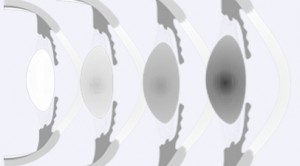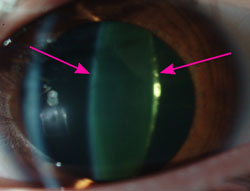One can classify and sort the different types of cataract in a number of ways:
Categorization According to Location of the opacity:
A nuclear cataract appears in the center of the lens. The nucleus is the inner, central, portion of the natural lens. This cataract generally develops with age and causes blurred vision as well as an image that appears darker and has a yellow-brown hue. In addition to blurred vision, there is also a gradual decline in the intensity of colors. This is the most common form of cataract. Additional types of cataract that can be classified according to the location of cloudiness (opacity) of the lens include a cataract of the peripheral areas of the lens (cortical), as well as a cataract of the posterior (back) layer, known as posterior sub-capsular. These two types of cataract are less common and, occasionally, their rate of development is faster. They generally cause significant blurriness and are liable to appear secondarily to a variety of different situations, such as trauma, diabetes, or previous eye surgery.
Categorization Based Upon the Degree of opacity:

The condition can be divided based upon whether the cataract is slight, intermediate, or significant (also known as a mature cataract). A very mature cataract does no allow for any meaningful vision in the affected eye and the pupil may appear cloudy (whitish), instead of its usual black color. In the distant past, when cataract surgery was extremely risky, the ophthalmologist would wait until the eye became completely blind, and only at that point would a cataract surgery be attempted. However, this approach is not appropriate today, when surgery is much, much, safer, recovery is quick, and the vision that is achieved following surgery is usually very clear. Therefore, today, patients prefer not to wait until they reach the point that they cannot see at all out of the affected eye, but rather, treat the cataract at an earlier stage.
Categorization based on age:
While most cases of cataract develop at a later age (older than 60), there are situations in which cataract may appear at a much younger age. Such cases can be secondary to multi-system illnesses, to other diseases of the eye, to medication, or to a congenital cataract. Occasionally, a cataract might develop due to genetic reasons which may cause cloudiness of the lens to develop at a young age. A congenital cataract (cataract at birth) differs greatly from a cataract which develops in adults. The childhood cataracts carries much higher risks of irreversible damage to sight, and the surgical techniques used in babies are unique and very different than the surgeries performed on adults.
Categorization Based Upon the Reason for the Development of the Cataract:
As I mentioned earlier, there are different factors that may cause the development of a cataract. Sometimes, these factors are not known, so that it may be difficult to determine the exact reason for the development of the cataract in a particular individual. In addition, in many cases, a number of factors interact in the formation of a cataract, so that it is difficult to “blame” any single cause for the development of a cataract in any specific eye. The most common cause of the development of a cataract is associated with age. This cataract, that was discussed earlier, develops as the result of degenerative changes in the lens which affect its clarity. A clear lens is transparent, like a glass of water, while an opaque, cloudy, lens is more like a glass of milk, which does not allow any transparency through it. The rate of development of a cataract which is secondary to advancing age is usually extremely slow, and continues over the course of many years. A common scenario is a situation in which at each sequential visits to the doctor, the patient sees approximately one line less than he did at the previous visit. This age-dependent deterioration is usually a nuclear cataract, which evolves over the years, and manifests as blurred vision and a gradual loss of the ability to discern colors well. Additional reasons for cataract include a list of causes that result in secondary cataracts, for example in association with: diabetes, high myopia (for example a glasses prescription of minus 10 to 20), high-dose irradiation, metabolic diseases related to the equilibrium of calcium in the body, and certain medications.



